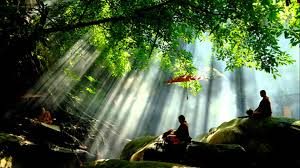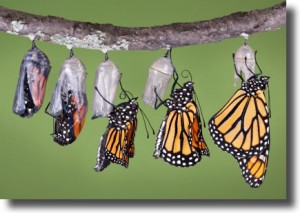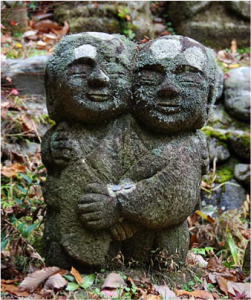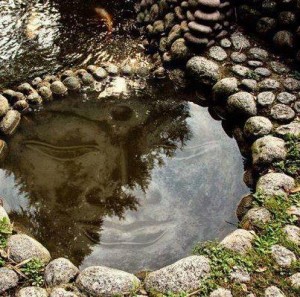 Our Moving into Meditation class continues to draw inspiration from Frank Ostaseski’s wonderful book about living with the awareness that we’re going to die. His book distills what he’s learned into Five Invitations we can answer in living a conscious life. In today’s class we worked with the fifth invitation to cultivate “don’t know mind.” This invitation seems to mirror queries found in the ancient Tao Te Ching. We drew inspiration from Ursula Le Guin’s elegant translation of the “Book About the Way and the Power of the Way.” She described it as “. . . the most lovable of all the great religious texts, funny, keen, kind, modest, indestructibly outrageous, and inexhaustibly refreshing. Of all the deep springs, this is the purest water. To me, it is also the deepest spring.”
Our Moving into Meditation class continues to draw inspiration from Frank Ostaseski’s wonderful book about living with the awareness that we’re going to die. His book distills what he’s learned into Five Invitations we can answer in living a conscious life. In today’s class we worked with the fifth invitation to cultivate “don’t know mind.” This invitation seems to mirror queries found in the ancient Tao Te Ching. We drew inspiration from Ursula Le Guin’s elegant translation of the “Book About the Way and the Power of the Way.” She described it as “. . . the most lovable of all the great religious texts, funny, keen, kind, modest, indestructibly outrageous, and inexhaustibly refreshing. Of all the deep springs, this is the purest water. To me, it is also the deepest spring.”
Guided Relaxation
Welcome to this moment . . . touching each breath ever so lightly . . . this awareness . . . this being . . . this feeling . . . this living . . . letting go . . . letting go of knowing . . . to enter the mystery . . . Can you sense the hard edges of knowing . . . the walls of the mind . . . do they guard or protect? Do they contain or imprison?
The ancient Tao Te Ching asks:
 Can you keep your soul in its body,
Can you keep your soul in its body,
hold fast to the one,
and so learn to be whole?
Can you center your energy,
be soft, tender,
and so learn to be a baby?
Can you keep the deep water still and clear,
so it reflects without blurring?
Can you love people and run things,
and do so by not doing?
Opening, closing the Gate of Heaven,
can you be like a bird with her nestlings?
Piercing bright through the cosmos,
can you know by not knowing?
 To give birth, to nourish,
To give birth, to nourish,
to bear and not to own,
to act and not lay claim,
to lead and not to rule:
this is mysterious power.
Can we let the mystery be?
Our practice of mindfulness may help free us from ordinary ways of seeing and knowing . . . in practice we enter direct experience again and again. Many teachers of mindfulness have described this state as “don’t know mind” – a mind that is curious and receptive – the beginner’s mind. Are we ready to meet whatever life offers?
Frank O. describes don’t know mind:
Don’t know mind . . . is beyond knowing and not knowing. . . .Don’t know mind is not limited by agendas, roles and expectations. It is free to discover. When we are filled with knowing, when our minds are made up . . . it obscures our ability to see the whole picture and limits our capacity to act. We only see what our knowing allows us to see.
 This moment right here before us . . . this relationship we are building, this pain and beauty we are facing – we have never experienced it before. When we enter a situation with don’t know mind, we have a pure willingness to do so, without attachment to a particular view or outcome. . . . our knowledge is always there in the background ready to come to our aid should we need it – but we let go of fixed ideas. We let go of control.
This moment right here before us . . . this relationship we are building, this pain and beauty we are facing – we have never experienced it before. When we enter a situation with don’t know mind, we have a pure willingness to do so, without attachment to a particular view or outcome. . . . our knowledge is always there in the background ready to come to our aid should we need it – but we let go of fixed ideas. We let go of control.
Don’t know mind is an invitation to enter life with free eyes, to empty our minds and open our hearts.
We can reflect on our attachment to controlling, reasoning, remembering . . . Our aversion to being out of control is so natural . . . yet so much of life is ungraspable . . . We often shrink from what we recognize as true: sickness, old age and death. In our fear, we sometimes withdraw – even from those we love. We can reflect on our reactivity to our own helplessness . . . Frank suggests:
To understand another’s disorientation or confusion, we must start with our own. . . . What is it like to be lost in the moment, to not know what is happening, to be unable to connect?
Meeting this experience with kindness and acceptance enables us to imagine how isolating it can be for those who can’t make themselves understood. We can feel empathy for their sense of loneliness, how frightened they might be. . . . We can appreciate how we might lash out in anger . . . out of the desire to regain control over our lives.
 This seems to echo the invitation of the Tao: Can [we] center [our] energy, be soft, tender, and so learn to be a baby? Can [we] keep the deep water still and clear, so it reflects without blurring? Can [we] love people and run things, and do so by not doing?
This seems to echo the invitation of the Tao: Can [we] center [our] energy, be soft, tender, and so learn to be a baby? Can [we] keep the deep water still and clear, so it reflects without blurring? Can [we] love people and run things, and do so by not doing?
Frank writes:
. . . Your calm presence, accompanied by compassionate touch can often provide a sense of order in the midst of chaos. . .
. . . make an effort to look past the surface and see the whole individual.. . . sit without doing, making space to simply be present without . . . busyness or . . . agendas. . . . strive to meet people with acceptance, listening from the heart, withholding and judgments . . .
This allows [us] to see the entire nature of relationships in a fresh way. [We] realize how false our notions of autonomy and separateness are; [we] . . . recognize our inseparability and interdependence. [We] feel [ourselves] becoming more human.
And this is how we practice together – so that we may feel ourselves becoming more human . . . to embrace the great mysteries of what it is to be human . . .
